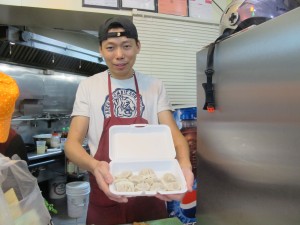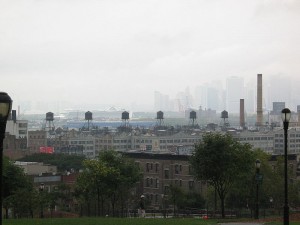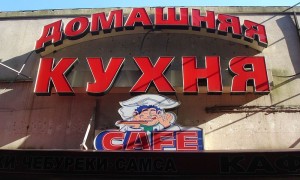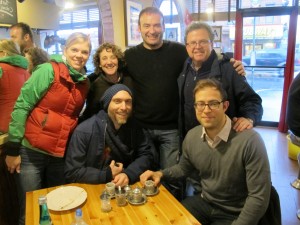We sampled black sesame ice cream at a shop on 8th Avenue in Brooklyn’s Sunset Park neighborhood, which now has New York’s third largest Chinatown. This enclave, located between southern Park Slope and Bay Ridge, has eclipsed lower Manhattan’s historic quarter. We could have sipped bubble tea, feasted on dim sum, and savored salted squid in this center of Asian commerce. The section, which the new settlers call “Bat Dai Do” (Big Eight Street), curiously enough, had once been the heart of Little Norway. The Scandinavians dubbed it Lapskaus Avenue for the name of a favorite beef stew. My father, who had grown up in Brooklyn, often recalled the ethnics who had brought their seafaring skills to the borough. Sunset Park was close to the waterfront where they worked.
Once colonized by the Dutch, Italians, and Irish as well, Sunset Park was acquiring a new identity. Chinese immigrants, predominantly Fujianese from south China, were transplanting their culture. They had followed the path of the N and R subway lines from Manhattan’s Chinatown to their new destination. This enterprising group could maintain a direct connection to a district where many still worked and shopped, while living in a less constricted space.
My wife, Peggy, and I were getting our introduction to this changing neighborhood from a Nosh Walk, one of a variety of weekly excursions to New York City’s ethnic neighborhoods led by Myra Alperson. Myra guided our band to the top of Sunset Park itself. From our perch we could see the harbor and the Verrazano Bridge. As we looked back down the slopes of the park, we could see families picnicking and cooking out in yards nearby. Vendors peddled food. They were part of the growing Latin population that had been putting down roots in Sunset Park. The newest settlers were largely Mexican. Not far away, amid Dominican, Ecuadorian, and Peruvian businesses on 5th Avenue, Mexican shopkeepers were carving out their own niche.
On another trek led by Myra, we got a rare glimpse into the city’s radically changing demography. She led us through “Little Odessa,” Brighton Beach, a heavily Russian neighborhood in Brooklyn. As we walked along Brighton Beach Avenue, which runs under the elevated tracks of the subway, I was struck by tell-tale signs of the community’s past and present. I noticed a fading sign for Mrs. Stahl’s Knishes, a reminder of the once-thriving American Jewish neighborhood. A vendor was selling pomegranate juice, a refreshment dear to Central Asians from the former Soviet Union. For passersby who looked forward to a brisk sauna, another hawker offered banya veniks, bundles of leafy tree branches, to use in a vigorous massage.
Myra shares absorbing historical and architectural details about neighborhoods during her walks. Brighton Beach was once a seaside resort built in the 1870s complete with race track, amusement park, and a posh hotel. Its developers were trying to emulate the English seaside resort, Brighton. Mother Jones, the labor activist, Myra told us, once lived here and a number of apartments were named for old socialists. The area took on an urban, grittier feel by the 1920s. The completion of the subway line from Manhattan enabled immigrant Jewish families to move away from the tenements of the Lower East Side to this roomier outpost near the ocean. The exodus of Soviet Jews, particularly from the Ukraine, who resettled in Brighton Beach during the 1970s, altered the neighborhood once again.
Food was the dominant motif of these tours. It is what drew participants and illuminated most sharply New York’s ethnic folkways. As New York Times reporter Joseph Berger observed of Nosh Walks, “like Napoleon’s army, her crew travels on its stomach.” There was an atmosphere of grandiosity in the vast M and I International food emporium Myra guided us into. For Russians used to stern austerity, the lavish culinary displays in this multi-floored establishment, a combination grocery, fast food eatery, and dessert café, broadcast excess. The store flaunted a surfeit of fish, smoked meats, cheeses, salads, and preserves. Standing in line, I was reminded of old regime vigilance: A burly bouncer glowered at me when I got too close to the counter.
We soon wandered into a produce store, Fancy Farm, and Peggy discovered a luscious prize, a bag of pomegranate seeds (arils). They soon began adding tang to our home salads. The store’s proprietors were Koreans who were conversant in Russian. An abundance of cakes, chocolates, and pastries awaited us later at La Brioche, a Russian pastry shop with a French accent. The Russian-speaking hostesses, who wore billowy chefs’ caps, served us Napoleons and other bountiful desserts.
A short walk off Brighton Beach Avenue toward the boardwalk and the ocean took us to an Uzbek café, a business emblematic of a community still in flux. Uzbeks, Tadjiks, and Georgians were introducing new flavors to the neighborhood. We sampled an oniony dumpling filled with pieces of
Our Brighton Beach tour leader, a school teacher by day, began guiding her guests through New York City’s ethnic quilt in 1983 when she launched Hungry Pedalers Gourmet Bicycle Tours. Seventeen years later Myra dreamed up a program of walking tours she called Nosh Walks. Its slogan is “Nosh your way from Odessa to Bombay … and never leave New York.” She takes her flocks through Manhattan, Brooklyn, and Queens, and even Staten Island, which now has a large Sri Lankan community and several eateries featuring that country’s cuisine. She has launched a walk through a favorite haunt of mine, Newark, New Jersey’s Ironbound section, a Portuguese stronghold, which is now getting an infusion of Brazilians and Ecuadorians. Along the way, Myra authored a book, Nosh New York, a culinary and cultural guide to the neighborhoods she tours.
Although I didn’t fully grasp it at the time, Nosh Walks offers a unique, 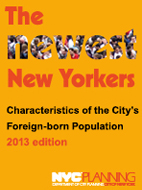 street-level view of the social upheaval reshaping New York. An absorbing report I’ve been reading documents the transformation. The Newest New Yorkers, published by the city’s planning and immigrant affairs departments and released in 2013, uses census and other survey data to highlight a fascinating trend—immigrants from the Third World supplanting Europeans as the Empire City’s largest foreign-born population. As recently as 1970, Italians, followed by Poles and Russians, were the top three groups among the new arrivals. In 2011, the Russians, who were already expanding from Brighton Beach to nearby areas, were the only Europeans in the top ten.
street-level view of the social upheaval reshaping New York. An absorbing report I’ve been reading documents the transformation. The Newest New Yorkers, published by the city’s planning and immigrant affairs departments and released in 2013, uses census and other survey data to highlight a fascinating trend—immigrants from the Third World supplanting Europeans as the Empire City’s largest foreign-born population. As recently as 1970, Italians, followed by Poles and Russians, were the top three groups among the new arrivals. In 2011, the Russians, who were already expanding from Brighton Beach to nearby areas, were the only Europeans in the top ten.
Two of the fastest growing groups in New York were based in Sunset Park. The Chinese, now the city’s second largest immigrant group (after Dominicans), have tripled in size over the past decade. The ethnics, no longer concentrated in Manhattan’s old Chinatown, have fanned out to Brooklyn and Queens. Sunset Park was one of the sizable enclaves springing up. Spreading south from Sunset Park, the Chinese have dramatically transformed Bensonhurst, a traditionally European ethnic neighborhood. Once strongly Italian, Sicilian in particular, the area has blossomed into the city’s largest immigrant Chinese community. Bensonhurst, where the opening scenes of Saturday Night Fever were shot and where the Honeymooners was set, is taking on a new character. Its hallmark bakeries, pork stores, and social clubs are fading, if not vanishing. I wondered if Spumoni Gardens, a restaurant beloved by friends Eliott and Steve Bhaerman, who grew up in the district, would survive?
Tidbits from The Newest New Yorkers
- The Chinese were the largest refugee group in New York City during the past decade.
- The Portuguese, in recent years Newark’s largest immigrant group, have been overtaken by Ecuadorians
- The Bronx has become a West African bastion. 75% of Ghanaians, for example, lived in the borough in 2011.
- Guyanese of Indian background tended to settle in Queens, while those of African descent were more likely to put down roots in Brooklyn.
* * *
The surge in New York’s Mexican community also explains the changing face of Sunset Park. The Mexican population, once tiny, has burgeoned, making it the city’s third largest immigrant group and its fastest growing. In the process, Sunset Park has risen to second place among the city’s biggest Mexican neighborhoods.
Nosh Walks not only opened up new vistas on this metropolis but also offered an inventive way to explore it. When I roamed New York in the sixties and seventies in search of culinary finds, my only guides were the Underground Gourmet handbooks. I stuck mainly to Manhattan’s byways. In the East Village, I chowed down on pierogis at Leshko’s, a Ukrainian eatery, and left Ratners, the venerable Jewish dining room, sated from strawberry blintzes. The B and H Dairy Luncheonette, a dairy restaurant on 2nd Avenue, was another favorite. There, a chopped herring sandwich was enlivened by the repartee of smart alecky countermen. Nearby was the Gem Spa, where I could grab a quick egg cream.
For something more unusual, friends and I traveled to Asia de Cuba, a Cuban-Chinese lunch counter in Chelsea, one of many such places opened up by Chinese émigrés from that Caribbean island. I took great pleasure in a plate of shrimp and yellow rice, fried plantains, and black beans, accompanied by sliced avocado. For the less adventurous, customers could choose from the half menu devoted to Chinese dishes.
My haphazard walks had only scraped the surface of ethnic New York. Reading the announcements of Nosh Walks has tantalized me, stirring yearnings to visit unfamiliar parts of Brooklyn and Queens. I am eager to investigate Astoria, once the capital of the Greek diaspora, and now increasingly populated by Egyptians, Moroccans, Brazilians, Bangladeshis, and other groups. A subway ride to Richmond Hill, near Kennedy airport, would take me to a center of Guyanese settlement. There, I gather from reports I have read, the Guyanese, who are largely of Indian background (descendants of the indentured laborers who worked the sugar plantations), have recreated a hybrid culture. In Little Guyana, you can munch on rotis, Indian flat breads stuffed with curried vegetables, goat, and chickpeas. Fusion dishes, like jerked chicken fried rice, reflect the culinary influence of the Chinese who migrated to the West Indian nation.
The advent of Nosh Walks means that my journeys to hidden sections of the city no longer have to be solitary. I can now wander through neighborhoods with other kindred and intrepid souls and with a savvy guide.
December 2014
